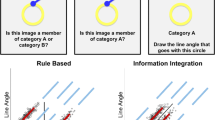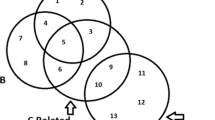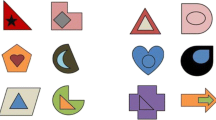Abstract
From an integrative approach, this work focuses on the role of conceptual mechanisms, such as comparison and conceptual-based inference, and sociopragmatic support in young children's taxonomic categorization. “Experiment 1” assessed whether 3-, 4-, and 6-year-old children succeed in detecting taxonomic relations on their own. A clear developmental trend was found: 6-year-olds succeeded, whereas 4- and 3-year-olds relied primarily on perceptually based categories. “Experiment 2” assessed if 3-year-olds are able to change their perceptual response into a taxonomic categorization as a function of the co-occurrence of contingent category information and feedback in an interactive process with an adult (experimenter). A pretest–posttest training study compared 3-year-olds' performance in four conditions: comparison, conceptual-based, information-only, and feedback-only. A perceptual–totaxonomic shift was found only in the comparison and conceptual-based training groups. Children who only received either category information or corrective feedback did not make such a shift. The results show that social interaction with supportive adults is a mechanism that drives conceptual understanding in early childhood.




Similar content being viewed by others
References
Baldwin, D. A. (1992). Clarifying the role of shape in children’s taxonomic assumption. Journal of Experimental Child Psychology, 54, 392–416.
Bauer, P., & Mandler, J. M. (1989). Taxonomies and triads: Conceptual organization in one-to two-year olds. Cognitive Psychology, 21, 156–184.
Benelli, B. (1988). On the linguistic origin of superordinate categorization. Human Development, 31, 20–27.
Blaye, A., & Bonthoux, F. (2001). Thematic and taxonomic relations in preschoolers: The development of flexibility in categorization choice. British Journal of Developmental Psychology, 19, 395–412.
Booth, A., Waxman, S. R., & Huang, Y. T. (2005). Conceptual information permeates word learning in infancy. Developmental Psychology, 41(3), 491–505.
Bowerman, M. (1976). Semantic factors in the acquisition of rules for word use and sentence construction. In D. M. Morehead & A. E. Morehead (Eds.), Normal and deficient child language (pp. 99–179). Baltimore: University Park Press.
Bruner, J. S., Goodnow, J. J., & Austin, C. A. (1956). A study of thinking. New York: Wiley.
Callanan, M. A. (1985). How parents label objects for young children: The role of input in the acquisition of category hierarchies. Child Development, 56, 508–523.
Callanan, M. (1991). Parent–child collaboration in young children’s understanding of categories hierarchies. In S. A. Gelman & J. P. Byrnes (Eds.), Perspectives on language and thought. Interrelations in development (pp. 440–484). New York: Cambridge University Press.
Chipman, S. F., & Medelson, M. J. (1979). Influence of six types of visual structure on complexity judgments in children and adults. Journal of Experimental Psychology: Human Perception and Performance, 5, 356–378.
Clark, E. (1973). What’s in a word? On the child’s acquisition of semantics in his first language. In T. E. Moore (Ed.), Cognitive development and the acquisition of language (pp. 65–110). New York: Academic.
Clark, E. (1988). On the logic of contrast. Journal of Child Language, 15, 317–335.
Cohen, L. B., & Oakes, L. M. (1993). How infants perceive a simple causal event. Developmental Psychology, 29, 421–433.
Fenson, L., Cameron, M. S., & Kennedy, M. (1988). Role of perceptual and conceptual similarity in category matching at age two years. Child Development, 59, 897–907.
Garton, A. F. (2001). Peer assistance in children’s problem solving. British Journal of Developmental Psychology, 19, 307–318.
Gelman, S. A., & Coley, J. D. (1990). The importance of knowing a dodo is a bird: Categories and inferences in two-year-old-children. Developmental Psychology, 26, 796–804.
Gelman, S. A., Colley, J. D., Rosengren, K. S., Hartman, E. H., Pappas, A., & Keil, F. C. (1998). Beyond labeling: The role of maternal input in the acquisition of richly structured categories. Monographs of the Society for Research in Child Development, vol. 63, no. 1.
Gentner, D. (1978). What looks like a jiggy but acts like a zimbo? A study of early word meaning using artificial objects. Papers and Reports on Child Language Development, IS, 1–6.
Gentner, D. (1988). Metaphor as structure mapping: the relational shift. Child Developoment, 59, 47–59.
Gentner, D., & Imai, M. (1995). A further examination of the shape bias in early word learning. Proceedings of the Twenty-Sixth Annual Child Language Research Forum, 167–176.
Gentner, D., & Namy, L. L. (1999). Comparison in the development of categories. Cognitive Development, 14, 487–513.
Gentner, D., & Rattermann, M. (1991). Language and the career of similarity. In S. A. Gelman & J. P. Byrnes (Eds.), Perspectives on thought and language: Interrelations in development (pp. 225–277). London: Cambridge University Press.
Golinkoff, R. M., Hirsh-Pasek, K., Bailey, L. M., & Wenger, N. R. (1992). Young children and adults use lexical principles to learn new nouns. Developmental Psychology, 28(99–1), 08.
Graham, S. A., & Diesendruck, G. (2010). Fifteen-month-old infants attend to shape over other perceptual properties in an induction task. Cognitive Development, 25, 111–123.
Graham, S. A., Kilbreath, C. S., & Welder, A. N. (2004). Thirteen-month-olds rely on shared labels and shape similarity for inductive inferences. Child Development, 75, 409–427.
Greene, T. R. (1994). What kindergartners know about class inclusion hierarchies? Journal of Experimental Child Psychology, 57, 72–88.
Imai, M., Gentner, D., & Uchida, N. (1994). Children’s theories of word meaning: The role of shape similarity in early acquisition. Cognitive Development, 9, 45–75.
Keil, F. C. (1989). Concepts, kinds, and cognitive development. Cambridge: MIT.
Keil, F. C. (1999). Conceptual change. In R. A. Wilson & F. C. Keil (Eds.), The MIT encyclopedia of the cognitive science (pp. 179–182). Cambridge: MIT.
Keil, F. C., & Batterman, N. (1984). A characteristic-to-defining shift in the development of word meaning. Journal of Verbal Learning and Verbal Behavior, 23, 221–236.
Kemler Nelson, D. G. (1995). Principle-based inferences in young children’s categorization: Revisiting the impact of function on the naming of artifacts. Cognitive Development, 10, 347–380.
Kotovsky, L., & Gentner, D. (1996). Comparison and categorization in the development of relational similarity. Child Development, 67, 2797–2822.
Kuhn, T. S. (1982). Commensurability, comparability, communicability. In P. D. Asquith & T. Nickles (Eds.), PSA 1982 (Vol. 2, pp. 669–688). East Lansing: Philosophy of Science Association.
Landau, B., Smith, L. B., & Jones, S. (1988). The importance of shape in early lexical learning. Cognitive Development, 3, 299–321.
Landau, B., Smith, L. B., & Jones, S. (1998). Object shape, object function, and object name. Journal of Memory & Language, 38, 1–27.
Madole, K. L., & Oakes, L. M. (1999). Making sense of infant categorization: Stable processes and changing representations. Developmental Review, 19, 263–296.
Mandler, J. M. (1992). How to build a baby II: Conceptual primitives. Psychological Review, 99, 587–604.
Mandler. J. M. (1998). Representation. In D. Kuhn, & R. S. Siegler (Eds.). W. Damon (Series Ed.), Hadbook of child psychology: vol 2. Cognition, Psychology, and Language (pp. 199-309). New York: Wiley.
Mandler, J. M. (2000). Perceptual and conceptual processes in infancy. Journal of Cognition and Development, 1, 3–36.
Mandler, J. M. (2004). The foundations of mind: Origins of conceptual thought. New York: Oxford University Press.
Markman, E. M. (1989). Categorization and naming in children: Problems of induction. Cambridge: MIT.
Markman, E. M., & Hutchinson, J. E. (1984). Children’s sensibility to constraints on word meaning: Taxonomic versus thematic relationship. Cognitive Psychology, 16, 1–27.
Markman, E. M., & Wachtel, G. F. (1988). Children’s use of mutual exclusivity to constrain the meaning of words. Cognitive Psychology, 20, 121–157.
Namy, L. L., & Gentner, D. (2002). Making a silk purse out of two sow’s ears: Young children’s use of comparison in category learning. Journal of Experimental Psychology, 131, 5–15.
Nelson, K. (1973). Some evidence for the cognitive primacy of categorization and its functional basis. Merrill-Palmer Quarterly, 19(2), 1–39.
Nelson, K. (1985). Making sense: The acquisition of shared meaning. New York: Academic.
Nelson, K. (1996). Language in cognitive development. The emergence of the mediated mind. Cambridge, England: Cambridge University Press.
Nelson, K., & Nelson, A. J. (1990). Category production in response to script and categories cues by kindergarten and second grade children. Journal of Applied Developmental Psychology, 11, 431–446.
Opfer, J. E., & Siegler, R. S. (2004). Revisiting preschoolers living things concept: A microgenetic analysis of conceptual change in basic biology. Cognitive Psychology, 49, 301–332.
Piaget, J., & Inhelder, B. (1959). La gene`se des structures logiques e´le´mentaires [The origin of elementary logical structures]. Neuchaˆtel: Delachaux & Niestle´.
Quinn, P. C. (2002). Category representation in young infants. Current Directions in Psychological Science, 11, 66–70.
Rakison, D. (2000). When a rose is just a rose: The illusion of taxonomies in infant categorization. Infancy, 1(1), 77–90.
Rakison, D. H., & Butterworth, G. E. (1998). Infants’ use of object parts in early categorization. Developmental Psychology, 34, 49–62.
Rogoff, B., Ellis, S., & Gardner, W. (1984). Adjustment of adult–child instruction according to child’s age and task. Developmental Psychology, 20, 193–199.
Smith, L. B., Jones, S. S., & Landau, B. (1992). Count nouns, adjectives, and perceptual properties in children’s novel word interpretations. Developmental Psychology, 28, 273–286.
Waxman, S. R. (1990). Linguistic biases and the establishment of conceptual hierarchies: Evidence from preschool children. Cognitive Development, 5(2), 123–150.
Waxman, S. R., & Gelman, R. (1986). Preschoolers’ use of superordinate level relations in classification and language. Cognitive Development, 1, 139–156.
Waxman, S. R., & Kosowski, T. (1990). Nouns mark category relations: Toddlers’ and preschoolers’ word-learning biases. Child Development, 61(5), 1461–1473.
Waxman, S. R., & Markow, D. B. (1993). Words as invitations to form categories: Evidence from 12-month-old infants. Cognitive Psychology, 29, 257–302.
Waxman, S. R., Senghas, A., & Benveniste, S. (1997). A cross-linguistic examination of the noun-category bias: Its existence and specificity in French- and Spanish-speaking preschool-aged children. Cognitive Psychology, 43, 183–218.
Winer, G. (1980). Class inclusion reasoning in children: A review of the empirical literature. Child Development, 51, 309–328.
Yu, Y., & Nelson, K. (1993). Slot-filler and conventional category organization in young Korean children. International Journal of Behavioral Development, 16, 1–14.
Acknowledgments
This research was supported by a Doctoral Fellowship from the National Research Council of Argentina to the first author and by Grant PIP 1099 from the National Research Council and Grant PICT 01754 from the National Agency of Scientific Promotion to the second author. We are grateful to the institutions and children who participated in this research. We also want to thank Georgene Troseth and the anonymous reviewers for their comments and suggestions on earlier drafts.
Author information
Authors and Affiliations
Corresponding author
Additional information
Olga Alicia Peralta. Professor of Educational Psychology-Scientific Researcher Consejo Nacional de Investigaciones Científicas y Técnicas (CONICET) (National Research Council) Argentina Address: Instituto Rosario de Investigación en Ciencias de la Educación (IRICE) (Rosario Institute for Research in Sciences of Education) 27 de Febrero 210 bis, 2000, Rosario, Argentina. Phone: +54-341-4821770, extension 204. E-mail: peralta@irice-conicet.gov.ar
Current themes of research:
Symbolic and conceptual development in young children. Social interaction. Cognitive development.
Most relevant publications in the field of Psychology of Education:
PERALTA, O. A. (1995). Developmental changes and socioeconomic differences in mother–infant picturebook reading, European Journal of Psychology of Education, 3, 261–272.
PERALTA, O. A. (1997). Estilos de interacción cognitiva materno-infantil en una situación de resolución de problemas en función del nivel socioeconómico y de la edad del niño. (Mother–child cognitive interaction styles in a problem-solving situation as a function of socioeconomic status and child’s age). Infancia y Aprendizaje, 80, 85–90.
PERALTA, O.A. and SALSA, A. (2003). Instruction in early in early comprehension and use of a symbol-referent relation. Cognitive Development, 1 (2), 269–284.
SALSA, A. and PERALTA, O. A. (2007). Routes to Symbolization: Intentionality and Correspondence in Early Understanding of Pictures. Journal of Cognition and Development, 8 (1), 79–92. Lawrence Erlbaum Associates. NJ-London.
PERALTA, O. and MAITA, M. (2010). El Impacto de la Instrucción en la Comprensión Temprana de un Mapa como Objeto Simbólico (The impact of Instruction in the early comprehension of a map as a symbolic object). Infancia y Aprendizaje. Madrid.
PERALTA, O. y SALSA, A. (2011) Instrucción y desarrollo en la comprensión temprana de fotografías como objetos simbólicos (Instruction and development in early comprehension of photographs as symbolic objects). Anales de Psicología, 27 (1), 118–125. Murcia.
MAITA, M. y PERALTA, O. (in press). La enseñanza materna de la función simbólica de un objeto (Maternal teaching of a symbolic function of an object). Cultura y Educación., 24 (3).
Andrea Sabina Taverna. Post Doctoral Student Consejo Nacional de Investigaciones Científicas y Técnicas (CONICET) (National Research Council) Argentina Address: Instituto Rosario de Investigación en Ciencias de la Educación (IRICE) (Rosario Institute for Research in Sciences of Education) 27 de Febrero 210 bis, 2000, Rosario, Argentina. Phone: 54 341 4821770 extension 204. E-mail: taverna@irice-conicet.gov.ar
Current themes of research:Conceptual development in young children. Social interaction. and Cognitive development.
Most relevant publications in the field of Psychology of Education:
TAVERNA, A. and PERALTA. O. (2009). Desarrollo conceptual: Perspectivas actuales en la adquisición temprana de conceptos. Conceptual development: current approaches to children’s early concepts acquisition. Psykhe, 18 (1), 49–59.
TAVERNA, A. and PERALTA. O. (2010). Rutas hacia la Formación del Significado de las Palabras. Naturaleza, Experiencia, Construcción y Contexto (Routes towards word meaning. Nature, experience, construction and context). Estudios de Psicología.
TAVERNA, A. y PERALTA, O. (2012). Comparación e Inferencia en la Categorización de Artefactos No-familiares. Un Estudio con Niños Pequeños (Comparison and inference in the categorization of non-familiar artifacts). Psykhé, 21 (1), 21–36.
Appendices
Appendix A
Appendix B
Rights and permissions
About this article
Cite this article
Taverna, A.S., Peralta, O.A. Young children category learning: a training study. Eur J Psychol Educ 28, 599–617 (2013). https://doi.org/10.1007/s10212-012-0130-9
Received:
Revised:
Accepted:
Published:
Issue Date:
DOI: https://doi.org/10.1007/s10212-012-0130-9




